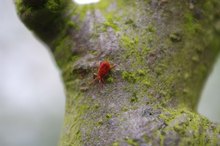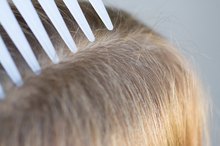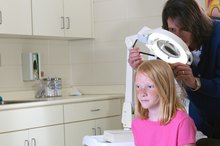There are a few different types of mites that can affect a hair follicle. Scabies are a common human skin mite that burrows into the skin and lays eggs. The larvae of the scabies mite can live in and feed off a hair follicle. Chiggers are the larval form of a mite found primarily in the southeastern and middle regions of the United States. These baby mites attach to the skin around pores and hair follicles and cause intense itching, according to the Missouri Department of Conservation 23. People all over the world have a microscopic mite, called demodex, which lives in the hair follicle, but generally does no harm unless the host develops a sensitivity to them. Treatment for scabies and demodex require a prescription medication from a doctor, but chiggers can be easily treated at home.
If you are experiencing serious medical symptoms, seek emergency treatment immediately.
Scabies
Visit your doctor to determine if you have a scabies infestation.
How to Get Rid of Scabies in the Hair
Learn More
Read and follow the instructions exactly as they appear on the scabicide your doctor prescribes. When used properly, scabicides will kill all mites, larvae and eggs including those found in your hair follicles.
Wash all bedding and clothing while you had scabies to prevent reinfestation.
- Visit your doctor to determine if you have a scabies infestation.
- When used properly, scabicides will kill all mites, larvae and eggs including those found in your hair follicles.
Chiggers
Mites That Live in a Human's Hair
Learn More
Wash the hair thoroughly with soap and water, using a washcloth to rub your scalp and skin. Chigger larvae do not attach very firmly and the rubbing action should dislodge those that are attached at your hair follicles. The water will rinse them away and drown them, according to the Missouri Department of Conservation 23.
Rub your scalp and skin with a dry washcloth or towel if you are unable to bathe. While this may not rid your body of all chiggers, it should reduce the number of them that are attached.
Wash the clothing you wore when you came in contact with the chiggers in hot, soapy water to kill any mites remaining on your clothing.
- Wash the hair thoroughly with soap and water, using a washcloth to rub your scalp and skin.
- Chigger larvae do not attach very firmly and the rubbing action should dislodge those that are attached at your hair follicles.
Demodex
Visit your doctor to determine if treatment is necessary for the demodex in your hair follicles. In most cases, they live there harmlessly. Your doctor will likely take a skin scraping to determine the concentration of demodex in your hair follicles and will likely only prescribe treatment if you are experiencing a negative reaction to their presence such as a rash or rough, dry and scaly skin.
Wash your face and body regularly to reduce the number of demodex living on your body, if your doctor opts not to prescribe a pesticide to kill the mites, advises the New Zealand Dermatological Society 4.
Exfoliate your skin periodically to remove dead skin cells and possibly decrease the number of demodex in your hair follicles.
- Visit your doctor to determine if treatment is necessary for the demodex in your hair follicles.
- Wash your face and body regularly to reduce the number of demodex living on your body, if your doctor opts not to prescribe a pesticide to kill the mites, advises the New Zealand Dermatological Society 4.
Related Articles
References
- Centers for Disease Control and Prevention: Scabies
- New Zealand Dermatological Society Incorporated: Demodex
- Fromstein S, Harthan J, Patel J, Opitz D. Demodex blepharitis: Clinical perspectives. Clin Optom (Auckl). 2018;10:57-63. doi:10.2147/opto.s142708
- Rather P, Hassan I. Human Demodex mite: The versatile mite of dermatological importance. Indian J Dermatol. 2014;59(1):60. doi:10.4103/0019-5154.123498
- Luo X, Li J, Chen C, Tseng S, Liang L. Ocular demodicosis as a potential cause of ocular surface inflammation. Cornea. 2017;36 Suppl 1:S9-14. doi:10.1097/ICO.0000000000001361
- Burkat C, Yen M. Demodex infestation. In: EyeWiki (American Academy of Ophthalmology). Updated May 3, 2020.
- Horváth A, Neubrandt DM, Ghidán Á, Nagy K. Risk factors and prevalence of Demodex mites in young adults. Acta Microbiol Immunol Hung. 2011;58(2):145-55. doi:10.1556/AMicr.58.2011.2.7
- Kosik-Bogacka DI, Łanocha N, Łanocha A, et al. Demodex folliculorum and Demodex brevis in healthy and immunocompromised patients. Ophthalmic Epidemiol. 2013;20(3):159-63. doi:10.3109/09286586.2013.789532
- U.S. National Library of Medicine. Permethrin topical. In: MedLine Plus. Updated January 15, 2018.
- Forton FMN, De maertelaer V. Treatment of rosacea and demodicosis with benzyl benzoate: Effects of different doses on Demodex density and clinical symptoms. J Eur Acad Dermatol Venereol. 2020;34(2):365-9. doi:10.1111/jdv.15938
- Evren Kemer Ö, Karaca EE, Özek D. Efficacy of cyclic therapy with terpinen-4-ol in Demodex blepharitis: Is treatment possible by considering Demodex's life cycle?. Eur J Ophthalmol. 2020;2020:1120672120919085. doi:10.1177/1120672120919085
- Jacob S, Vandaele MA, Brown JN. Treatment of Demodex-associated inflammatory skin conditions: A systematic review. Dermatol Ther. 2019;32(6):e13103. doi:10.1111/dth.13103
Writer Bio
Sophie Stillwell has been writing professionally since 1992. She is published in "The Gorham Times" newspaper, "Private Colleges & Universities" magazine, on eHow and in several other publications. She has experience working as a paralegal, antiques dealer and neurobehavioral coach. Her writing topics frequently include frugal living, pets and health. Stillwell holds a Bachelor of Arts in English from the University of Southern Maine.








